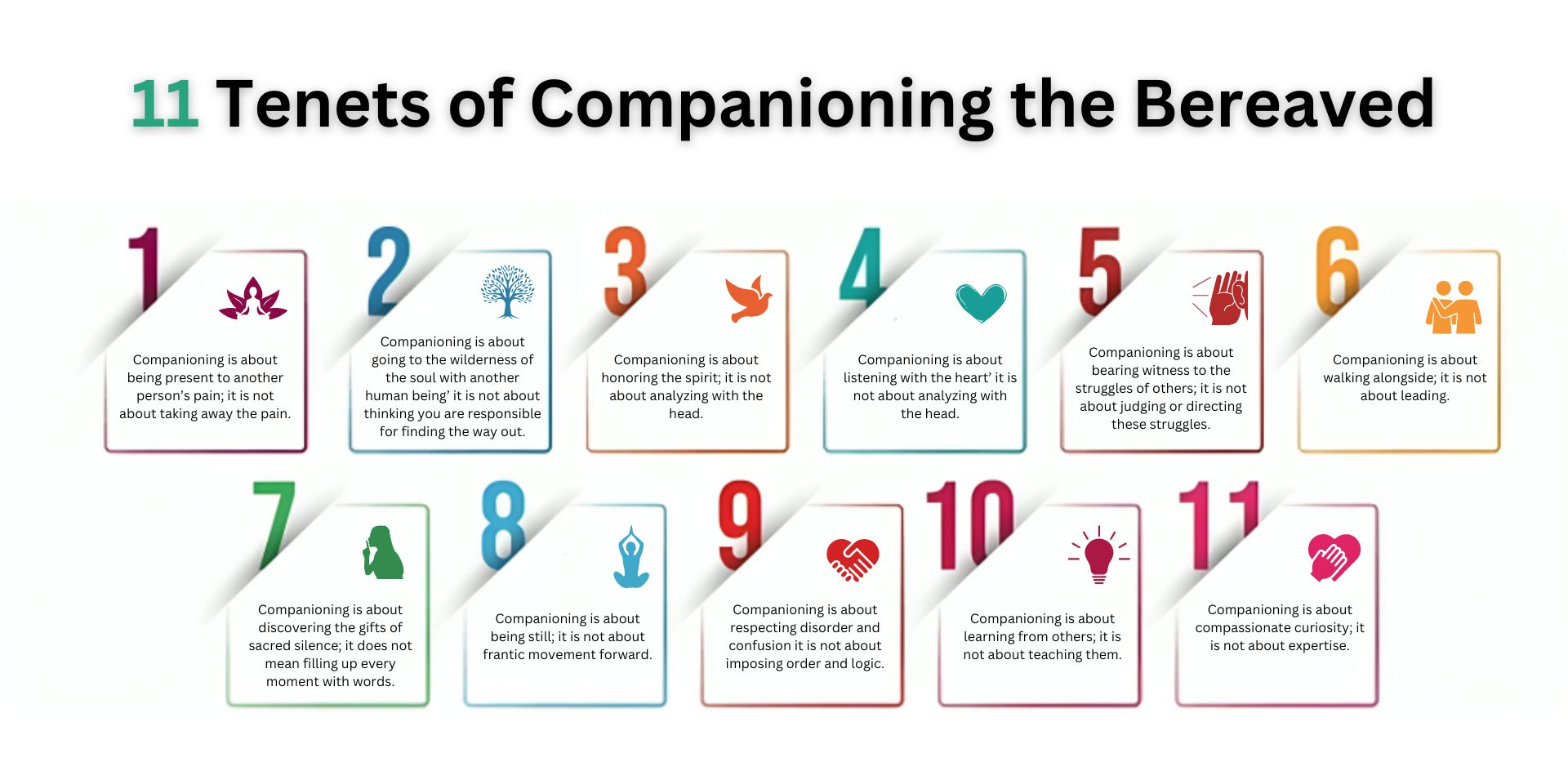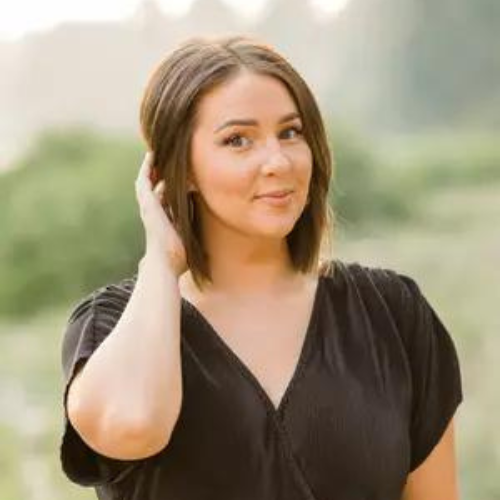
A Clinician's Guide to Understanding the Companioning Model of Grief
Grief is a deeply personal experience, which presents uniquely, not only from one person to the next, but also from one loss to the next. This highly individualized experience requires an approach for each client that is as unique as they are, allowing the griever to lead their own grief journey, and learn in tandem with the support of a companion. The Companioning Model of Grief, founded by Dr. Alan Wolfelt, offers clinicians a compassionate, human-centered approach to supporting clients through their loss.
This guide will explore the key principles of the companioning model, including the intricacies and efficacy of the technique and how clinicians can apply it to support individuals on their grief journey.
What is the Companioning Model of Grief?
Grief is the natural internal reaction to a loss experienced by an individual. The Companioning Model of Grief, founded by Dr. Alan Wolfelt, offers a human-centered, compassionate alternative to standard grief counseling or therapy as it embraces the experience of the bereaved as one to be more deeply understood rather than treated or resolved. Within this model, grief is not a problem to be solved, but rather an experience to be processed and supported.
Unlike traditional, or more well-known models of grief work, like Elizabeth Kubler-Ross’ 5-Stages of Grief, the Companioning Model focuses on honoring the individual’s unique grief experience, placing the bereaved in the seat as the expert of their own experience. It emphasizes the role of the clinician, or “companion” as one of supportive presence and compassionate curiosity – uplifting the role of “being” with the bereaved, walking alongside them as they navigate their own unique grief journey.
FREE DOWNLOAD:
Transform your approach to grief counseling with our specially curated Companioning Model of Grief Reading List. This invaluable resource offers mental health professionals profound insights and practical tools to foster deeper, more compassionate connections with grieving clients. Download now to access proven methods that can truly make a difference in your clients' healing journeys.

Key Principles of the Companioning Model
To begin to build a framework for how to work with clients within the Companioning Model of Grief, it is important to first understand the following basic principles that are essential to the foundation of this approach:
- Listening Versus Fixing: As humans and helping professionals, it is in our nature to desire to help a client find a path to “resolution”. However, within the framework of the Companioning Model, the work surrounds the practice of listening and holding space for the lack of resolution, which is so often present within grief.
- Respecting Individual Grief Journeys: As a grief companion, one will encounter bereaved individuals from a variety of backgrounds, beliefs, and lived experiences which will conflict with our own. Throughout our work with each client, we must hold space for differences within grief journeys, taking into consideration their background, their losses, and the inherent differences in their own process.
- Presence Over Prescriptions: Holding space as a primary tenant of companioning requires a clinician to sit with discomfort, deep sadness, anger, at times suicidal thoughts, and much more without working toward a “fix” for these feelings. Within this framework deep trust is placed on the bereaved to work through their own journey which is essential to healing.
- Creating a Safe Space for Grief: The question will often come up from clients “is this normal?” or “am I crazy?” as a result of the client sharing thoughts and feelings that they have never said aloud. This is a sign of deep trust within the therapeutic relationship, as well as a sign that a safe space has been created. This safe space is facilitated through holding space and compassionate curiosity which allows the bereaved to process through their grief with a safe sounding board, free from judgment.
- Non-Pathologizing Grief: Throughout the grief companioning process, clients often seek out normalization of their own experience. Individuals want to know that they are on the right track. As we work to normalize, we support our clients in seeing their grief experience as a natural response rather than a disorder to be treated.
INSTANT WEBINAR
Whether you're new to grief work or looking to enhance your current approach, this webinar will provide practical insights and techniques to help you be a compassionate companion in your clients’ healing journeys.

How Companioning Grief Differs from Traditional Grief Counseling
The guiding role of the Companion: “I am not the expert on your grief, you are. Why don’t you tell me about your experience and we will walk this journey together.”
The Companioning Model of Grief differs from traditional grief counseling in a variety of ways which includes:
The Role of the Clinician:
- Traditional: Views the clinician within the role of the “expert”.
- Companioning: Shifts the clinician from the role of “expert” to the role of companioning, placing the bereaved in the role of “expert” of their own experience.
Process Oriented over Treatment Plan and Resolution-Oriented:
- Traditional: Creates a structured format and a treatment plan for discharge through measuring outcomes.
- Companioning: Emphasizes the ongoing therapeutic relationship.
Timelines:
- Traditional: Works along a timeline with measurable outcomes related to “resolution”
- Companioning: Recognizes the lack of an “end” to a grief timeline, making space for ongoing, lifelong grief experiences.
Techniques for Clinicians Using the Companioning Model
Upon initial look one might view the Companioning Model as just “sitting and listening,” which isn’t necessarily wrong, however there is far more intention behind these practices. While it may seem easy at first, the techniques highlighted often push against the traditional therapist mindset. The following techniques, when used intentionally, create a deeply safe space where grievers feel comfortable going deeper and deeper into their grief experience. Oftentimes divulging thoughts and feelings they have never said aloud, or truly acknowledged exist.
Active Listening: Companions who utilize the companioning grief model will often enlist powerful listening tools that allow their client to feel truly heard as they navigate their own grief journey. These tools may include reflective listening, asking open-ended questions, or therapeutic use of silence.
Emotional Presence: Not unlike the typical therapeutic setting, grief companions will bring an empathetic emotional presence to each session with a griever. Unlike traditional therapy, the element of “leaving yourself at the door” is not necessarily present. In companioning, genuine, empathetic responses rooted in one’s own lived experience is seen as a powerful tool.
Validation of Grief Experience: Within grief, individuals have a deep need to feel seen, understood, and validated. Grief is inherently isolating, and often makes the griever feel like they are the only one who has ever felt how they are feeling, or thought what they are thinking. Within the companioning relationship, consistent validation is often sought out and deeply impactful.
Non-Directive Support: Individuals in grief are often seeking guidance within their grief journey. Unfortunately, due to the unique nature of each individual’s grief, one solution does not fit all. For this reason, as well as the sincere need for grievers to build up their belief that they are the experts of their own grief experience, companions will not often offer direct solutions for an issue being faced. Rather, they will ask more questions, helping the griever begin to rely on their own interventions.
Following their Lead: As a clinician, it may feel counterintuitive not to walk into a session with a client with an intervention plan. However, because this model is directed by the bereaved, a grief companion may not know what areas of support will be most needed on any given day. Grief is unpredictable, making each session potentially a vastly different process than the last.

The Value of Companioning in Grief Work
While the Companioning Model of Grief is a clear departure from a typical therapeutic modality, its methods and effectiveness is backed by both research as well as observation of long-term outcomes for grieving individuals. When focusing on what components are truly effective, special attention should be paid to the companioning model’s focus on presence and empathy which directly impacts the therapeutic relationship between the client and provider. Studies suggest that a strong therapeutic relationship is one of the most critical predictors of successful outcomes in therapy, with some research showing that it accounts for as much as 30% of treatment effectiveness.
In addition to more positive therapeutic outcomes, clients also report a higher level of satisfaction with the care they have received. In a recent survey conducted, clients report feeling more understood and validated within their grief process, leading to a significant improvement toward healing. Clients of this model also report satisfaction with being able to process through their grief at their own pace, while also understanding the non-linear nature of grief – normalizing their own unique experience.
Feedback from bereaved individuals who have had the opportunity to experience the Companioning Model of Grief is a stunning testament to the value of this model, not only in supporting a client effectively throughout their grief process, but also in building their confidence in their own ability to navigate challenging times when they happen again in the future.
Additional Resources for Clinicians
There are a variety of resources for those who are interested in learning more about The Companioning Model of Grief. Specifically, Dr. Alan Wolfelt has spent his career not only developing this model and teaching it live at the Center for Loss and Life Transition, but also has written countless books to support the diverse variety of grief experiences a clinician will face throughout their career.
To begin, we suggest reading Companioning the Bereaved: A Soulful Guide for Caregivers.
Final Thoughts: How ICANotes Supports Clinicians in Grief Work
The Companioning Model of Grief empowers clinicians to journey alongside grieving clients, offering non-directive support that respects each client’s unique experience. ICANotes can be an invaluable asset for clinicians adopting this model. Designed specifically for behavioral health professionals, ICANotes allows clinicians to create detailed, individualized notes quickly, capturing the nuances of each client’s grief journey. This EHR software automates accurate coding and billing, helping ensure maximum reimbursement while reducing documentation time, so clinicians can focus more on client care rather than administrative tasks.
With ICANotes, clinicians gain access to robust support and customizable features, which enhance the flexibility and effectiveness of grief companioning. For example, ICANotes’ structured charting tool offers prompt reminders and facilitates thorough documentation, helping reduce clinical and legal risks often associated with incomplete notes. By simplifying note-taking and streamlining administrative processes, ICANotes enables clinicians to better serve clients through every phase of their grief journey.
Sign up for a free trial (no credit card required) or schedule a demo to explore how ICANotes can support your grief work with clients.
About the Author

Kaylee, a certified grief counselor and social worker, has dedicated the past decade to reshaping our understanding and support of grief. With experience at a nonprofit hospice, she's empowered individuals to navigate their grief journeys, recognizing that loss extends beyond death. As an author, speaker, and event organizer, Kaylee fosters spaces for acknowledging and embracing life's most challenging moments. Her work has been featured across various media, amplifying voices and broadening awareness of the diverse sources of grief in our lives.
Recent Posts
Sources
- Dr. Alan Wolfelt and his work on the Companioning Model of grief, particularly his books and resources from the Center for Loss and Life Transition.
- Studies on therapeutic alliance and its impact on treatment outcomes, such as the research by Horvath, A. O., and Symonds, B. D. (1991).

